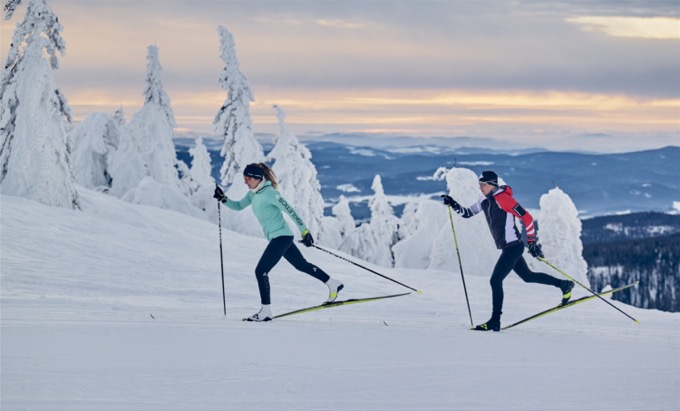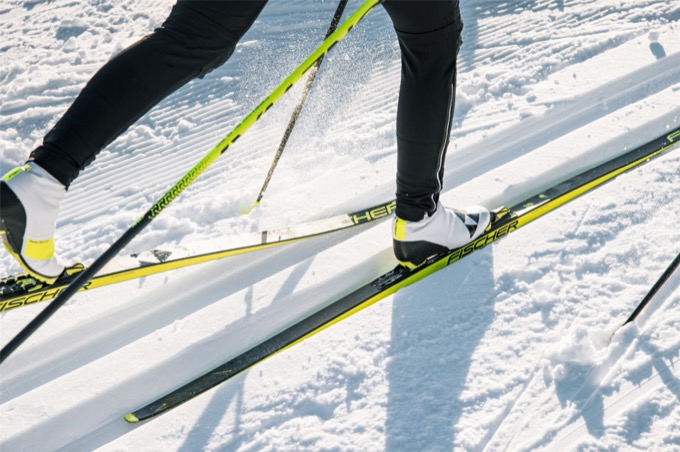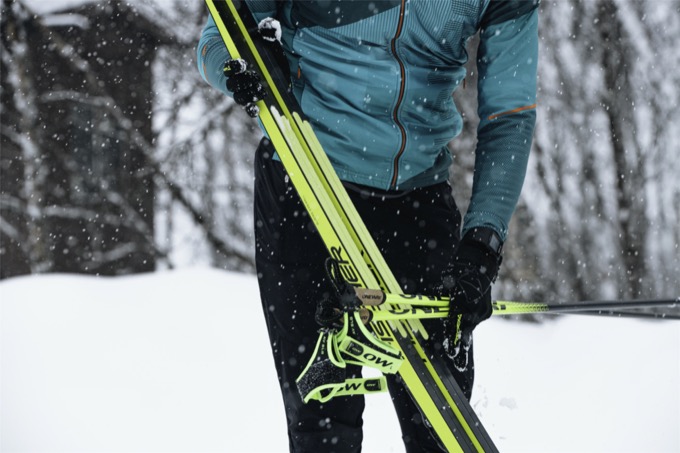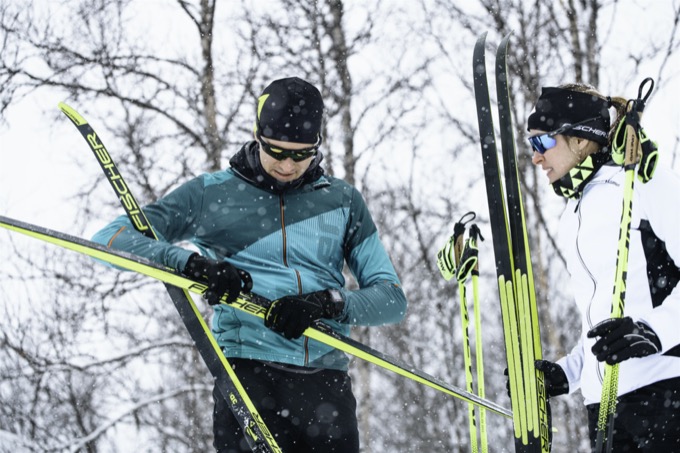
Table of Contents
Choosing what classic cross country ski gear to buy can be overwhelming. There are a lot of choices to make and a lot of jargon to unpack.
This article provides a comprehensive overview for the beginner in classic skiing. After you figure out your gear, be sure to come back and watch our videos for learning cross country ski techniques.
Did you know we have instructional cross-country ski videos?
For skiers just getting started:
- Classic vs Skate Skiing: Which is right for you?
- First Day Lesson for Absolute Beginners
- Help for struggling skate skiers: The One Skate Dance Drill
Classic and Skate Skiing
When it comes to skiing on machine groomed ski trails at Nordic Ski areas, there are two major styles of cross-country skiing:
- Classic Skiing
- Skate Skiing
The equipment and mechanics differ between the styles, but the skiing techniques share fundamental movements. Many Nordic skiers both skate and classic ski.
[Do you need help deciding between skate and classic skiing? This video will help: Classic vs Skate Skiing: Which is Right for You?]
Classic Skiing
Classic skiing is the older and more traditional style of cross-country skiing. It’s what most people imagine when they think of Nordic skiing.
For classic skiing, you will need:
- Skis
- Poles
- Boots and bindings
You’ll also need Country Ski Clothes and Accessories.
Most Nordic ski shops will offer you a discount if you buy a “package”, which means skis, poles, boots and binding all together.
Can I use the same equipment for skate and classic skiing?
The short answer is no. Classic cross country and skate skis are constructed differently because the mechanics of how you push against the ski in skate and classic skiing are different.
- Classic skis are longer than skate skis.
- There are other differences that are less easy to see but are still important.
- Classic ski poles are shorter than skate ski poles.
- Classic boots are similar in shape to a running shoe, while skate boots have a high, supportive ankle cuff.
There is a type of cross-country ski boot called a pursuit boot (or combi boot) that works for classic and skate skiing.
You can save money by starting with that boot if you want to do both styles, but I think you’d be better off in the long run buying a classic or skate boots right from the start.
How Classic Skis Work

Classic skis run in parallel tracks that are set in the snow approximately shoulder width apart.
To understand how the skis work, you need to know how they are constructed. Two things are important:
- The skis are flexed into a bow-like shape, called a camber.
- There’s a sticky area on the base of the ski, under the foot, that sticks to the snow when you push down and flatten the ski.
The Camber
Classic skis are long, narrow and flexed in a bow-like shape. If you hold a pair of skis together with the bases facing each other, the tips and tails touch, but there’s a gap between the skis in the area underfoot. The bow-like shape is called the camber.
The Grip Zone
There’s a area along the base of the ski, under the foot called the “grip zone”. It goes by other names too, such as the “kick zone” or “wax pocket”.
The grip zone extends from the heel of the binding forward, several inches ahead of the toes. The grip zone is essential to the proper fit and function of the ski.
How the Camber and Grip Zone Work
When the skier stands with her weight balanced between the skis, the skis glide freely because the grip zone is held above the snow by the skis’ bow-like construction (camber).
To move forward, the skier moves her weight over one ski and pushes down and back in an action called “the kick”.
Pushing down flattens the ski. The grip zone momentarily sticks to the snow, giving the skier some friction to push against.
Classic Skis: Waxable vs Waxless

Classic cross country skis are broadly grouped into two categories, based on the type of grip zone:
- Waxable Skis
- Waxless Skis
Waxable Skis
On waxable classic skis, the skier applies a special kind of wax called grip wax or kick wax to the base of the ski in the grip zone.
Because the properties of snow change with age and temperature, you need a range of kick waxes to suit different conditions.
You apply kick wax, usually before every ski outing, but even while out on the trail, especially if the snow conditions change during your ski.
The wax comes in a small metal tube and gets rubbed on with a cork and scraped off, when necessary, with a small plastic scraper.
Waxable skis are the more traditional type of classic cross country ski. They are almost always used in competition because they are faster than waxless skis and the wax can be customized for various situations to maximize both the grip and the glide.
Waxless Skis
Waxless ski technology has improved dramatically in recent years and performance is not longer compromised as much as it used to be.
“Waxless” is a bit of a misnomer, because even a waxless ski needs to be waxed regularly on the glide zones. (The tips and tails of the base.)
“Waxless” refers to the type of grip zone on the base of the ski. (See above for an explanation of “grip zone”.)
Instead of the grip coming from a sticky wax applied to the base, the grip comes from the ski itself.
There are 3 kinds of waxless classic skis:
- Skin Skis – have a mohair like material inserted into the base of the ski.
- Fishscales – have ridges built into the base of the ski that help provide traction.
- Rub Skis or “Zeros” – have an alternate material in the base that is roughed up with sandpaper prior to skiing. Unlike skin skis and fishscales, “Zeros” are often used in competition and are considered a race-style ski.
Skin skis are fast becoming the most popular type of waxless ski, but fishscales and zeros also have their place.
This article explains more about waxable vs waxless skis:
Sizing classic cross country skis
Classic skis are fit to the skier’s weight and height. Of the two factors, weight is most important because your weight needs to be matched to the camber (flex) of the ski.
If the skis are too soft for you, they won’t glide well. If they are too stiff you won’t be able to flatten the ski and make the grip zone stick to the snow. Your skis will slip out and it will be difficult to move forward.
Fitting a ski takes skill, knowledge and experience, which is why you should buy from a local Nordic Ski Shop or from an experienced skier who knows how to test the fit of a ski.
Things to know
- Long skis are not necessarily faster than short skis.
- Stiff skis are not necessarily faster than soft skis.
- The speed of a ski depends on many factors and changes with snow conditions.
- Racers have multiple pairs of skis so they can choose the fastest pair for the conditions on race day.
- Regular skiers can own 1 nice pair of skis that performs well in a broad range of conditions.
Caring for your classic skis
The base of your classic skis need to be regularly treated with glide wax. Even waxless skis need to be periodically glide waxed.
Glide wax is applied with a special iron and scraped and brushed off on a special table, called a wax table or ski form.
You can do that at home, but it requires specialized equipment and skill. It’s easier to drop off your skis at your local shop and have them do it.
When you buy your skis, ask for “ski ties” and don’t chose the wrap around velcro ones. Chose the sleeve-like ones. Use these whenever carrying your skis to help protect them.
A ski bag is also a good way to protect your skis from damage and makes it easier to manage multiple pairs of skis.
Classic Ski Poles

For a more in-depth discussion of poles, refer to this article, which includes an explanation of how to calculate the right pole length.
How to Buy Perfect Cross Country Ski Poles
The key points are:
- Poles matter because you actively push yourself along with both the skis and the poles.
- Poles come in various materials. Aluminum is heavy. Carbon is lovely – light and has a beautiful swing feel, but these poles are very expensive and more fragile.
- Composite poles are a nice, in between option and provide excellent mid-level value.
- Buy a pole with a harness, not a loop strap.
Classic Ski Boots and Bindings
The most important thing to consider when buying ski boots is comfort. The boots should fit like a running shoe.
Oversized, fleece-lined boots won’t do much to keep your feet warm and make it harder to ski with good technique. If you have trouble with cold feet, refer to the advice in this article:
What to Wear Cross Country Skiing
There are 2 systems of boots and bindings: NNN and SNS. NNN dominates the market and is the better choice, not because it works better, but because it’s most ubiquitous.
The systems are not interchangeable. The boot system and binding system must be compatible. Check this, if you are buying used gear.
Boots, bindings and skis must match in terms of intended purpose. For example, you shouldn’t use a heavy backcountry boot on a lightweight race ski.
Manual bindings are superior to automatic bindings and well worth the extra, nominal cost. They are much easier to attach and detach and less likely to ice up.
Buying Advice
Buy for the skier you aspire to be, not the skier you are.
If you want to ski with the fast, graceful techniques used in cross country ski races, then you should buy race level gear.
Like everything else in life, you get what you pay for. Work out your budget (including clothes and accessories) and buy the best you can afford, reasonably.
The quality of your gear will affect the ease of learning and the joy of skiing.


